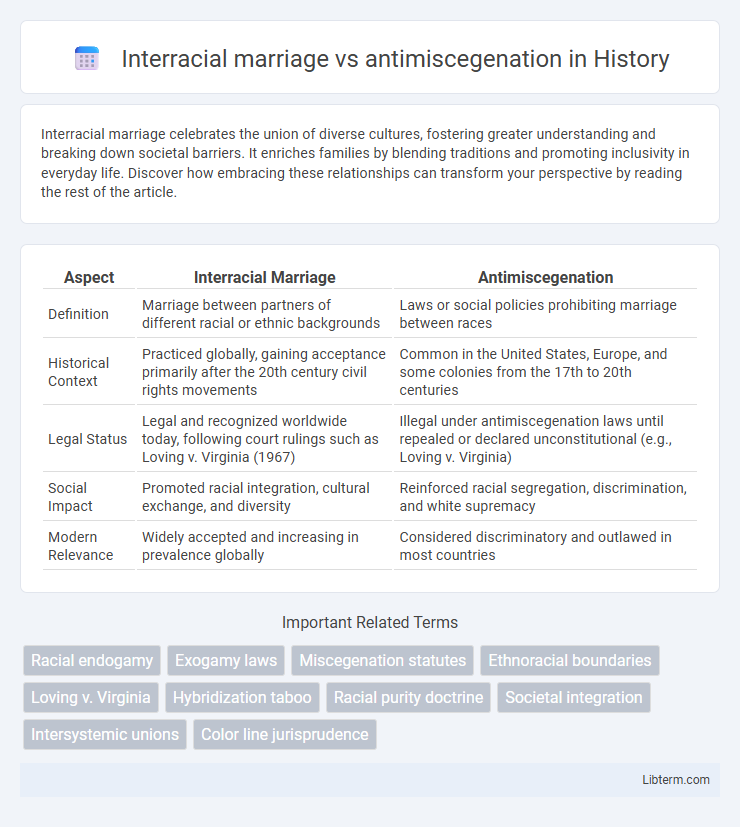Interracial marriage celebrates the union of diverse cultures, fostering greater understanding and breaking down societal barriers. It enriches families by blending traditions and promoting inclusivity in everyday life. Discover how embracing these relationships can transform your perspective by reading the rest of the article.
Table of Comparison
| Aspect | Interracial Marriage | Antimiscegenation |
|---|---|---|
| Definition | Marriage between partners of different racial or ethnic backgrounds | Laws or social policies prohibiting marriage between races |
| Historical Context | Practiced globally, gaining acceptance primarily after the 20th century civil rights movements | Common in the United States, Europe, and some colonies from the 17th to 20th centuries |
| Legal Status | Legal and recognized worldwide today, following court rulings such as Loving v. Virginia (1967) | Illegal under antimiscegenation laws until repealed or declared unconstitutional (e.g., Loving v. Virginia) |
| Social Impact | Promoted racial integration, cultural exchange, and diversity | Reinforced racial segregation, discrimination, and white supremacy |
| Modern Relevance | Widely accepted and increasing in prevalence globally | Considered discriminatory and outlawed in most countries |
Understanding Interracial Marriage: Definition and Context
Interracial marriage refers to the union between partners of different racial backgrounds, reflecting increasing social acceptance and diversity worldwide. Historically, antimiscegenation laws prohibited such marriages, reinforcing racial segregation and inequality in countries like the United States until their invalidation by the Supreme Court in 1967's Loving v. Virginia case. Understanding interracial marriage involves recognizing its role in challenging racial barriers and promoting cultural integration within modern societies.
Antimiscegenation Laws: Historical Overview
Antimiscegenation laws, enforced primarily in the United States from the colonial era until the mid-20th century, prohibited interracial marriages and relationships to maintain racial segregation and white supremacy. These laws targeted unions between White individuals and people of African, Native American, Asian, and other non-white descents, resulting in criminal penalties, social stigmatization, and legal challenges. The landmark 1967 Supreme Court case, Loving v. Virginia, ultimately declared all antimiscegenation statutes unconstitutional, affirming the right to interracial marriage as a fundamental freedom.
Social Attitudes Toward Interracial Relationships
Social attitudes toward interracial relationships have evolved significantly, with increasing acceptance in many societies contrasted by persistent antimiscegenation sentiments in others. Studies from the Pew Research Center reveal that, as of recent years, over 60% of adults in the United States support interracial marriage, reflecting a shift from the historical stigma and legal bans in place until the 1967 Loving v. Virginia Supreme Court decision. Despite progress, some communities maintain resistant views rooted in cultural, religious, or socioeconomic factors that continue to influence social dynamics around interracial unions.
Legal Battles: Dismantling Antimiscegenation Statutes
Legal battles over interracial marriage have been pivotal in dismantling antimiscegenation statutes that prohibited unions between different racial groups. Landmark cases such as Loving v. Virginia (1967) struck down state laws banning interracial marriage, affirming the constitutional right to marry regardless of race. These rulings not only invalidated discriminatory legal frameworks but also set critical precedents promoting racial equality and civil rights in marriage laws across the United States.
Cultural Impacts of Interracial Marriage
Interracial marriage fosters cultural exchange, blending traditions and promoting social inclusivity, which challenges long-standing prejudices rooted in antimiscegenation laws. This union facilitates the breakdown of racial barriers, encouraging acceptance and understanding across diverse communities. The cultural impacts include enriched family dynamics, increased cross-cultural dialogue, and a gradual shift toward more inclusive societal norms.
Interracial Unions: Myths and Realities
Interracial marriages challenge longstanding myths by demonstrating that cultural and racial differences do not hinder successful, loving partnerships, contrary to the false assumptions underpinning antimiscegenation laws. Sociological studies reveal that interracial unions contribute to social integration and reduce racial prejudices, while data shows increasing acceptance and prevalence of these marriages globally. Realities debunk myths of incompatibility, highlighting shared values and mutual respect as the foundation of healthy interracial relationships.
Antimiscegenation and Systemic Racism
Antimiscegenation laws, rooted in systemic racism, prohibited interracial marriages to maintain racial hierarchy and social segregation within the United States until their repeal in 1967 with Loving v. Virginia. These laws reinforced racial discrimination by legally enforcing separation and perpetuating white supremacy through institutionalized barriers. Despite legal advancements, systemic racism continues to influence societal attitudes and disparities affecting interracial couples and broader racial equality.
Contemporary Challenges for Interracial Couples
Contemporary challenges for interracial couples often stem from lingering societal prejudices and cultural misunderstandings rooted in historic antimiscegenation laws. Discrimination, stereotyping, and family disapproval continue to impact relationship dynamics and social acceptance. Navigating identity, raising multiracial children, and confronting bias remain crucial obstacles for interracial marriages today.
Global Perspectives: Interracial Marriage Around the World
Interracial marriage rates vary significantly worldwide, reflecting diverse cultural attitudes and legal frameworks. Countries like the United States, Brazil, and South Africa show high interracial marriage prevalence due to multicultural societies and evolving social norms. In contrast, some nations maintain antimiscegenation laws or social taboos, limiting such unions and perpetuating racial segregation.
The Future of Interracial Relationships and Legislation
Interracial marriage continues to gain legal recognition and social acceptance worldwide, reflecting a growing emphasis on diversity and equality. Legislative bodies are increasingly repealing or rejecting antimiscegenation laws that historically prohibited interracial unions, promoting human rights and anti-discrimination policies. Technological advancements in social media and dating platforms further facilitate interracial connections, signaling a future where legal constraints diminish and cultural integration strengthens.
Interracial marriage Infographic

 libterm.com
libterm.com